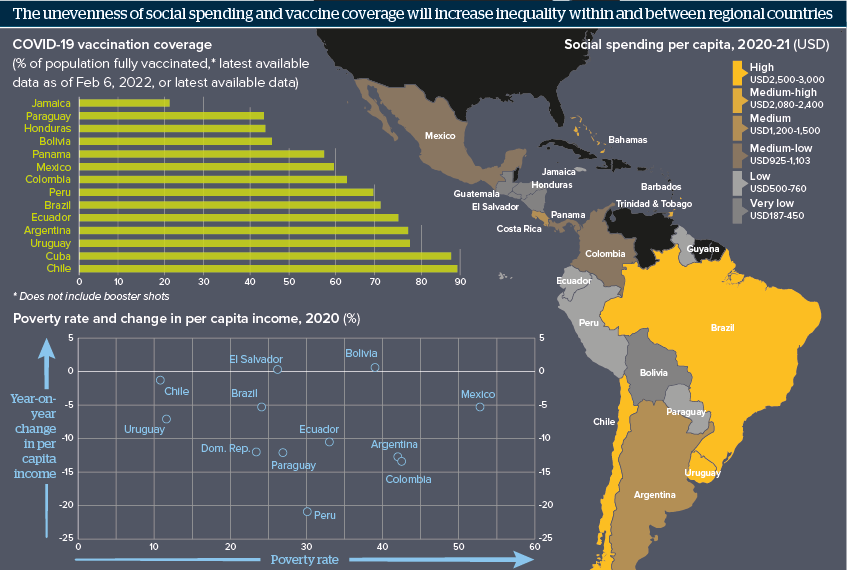Post-pandemic inequality will endure in Latin America
The pandemic has undone much recent progress in poverty and inequality figures, possibly for some time to come
Source: UN Economic Commission for Latin America and the Caribbean (ECLAC); Our World in Data
Outlook
Despite rising vaccination rates, Latin America accounted for nearly 29% of global COVID-19 deaths by end-2021.
COVID-19’s effects have also been far wider: according to ECLAC, poverty fell marginally in 2021, but at 201 million people under the poverty line across the region it remained above 2019 rates. Extreme poverty rose from 81 million people in 2020 to 86 million in 2021 -- a level not seen in over 30 years. Emergency welfare spending fell from USD89.7bn in 2020 to USD45.3bn last year; the continuing decline will have knock-on effects.
Across the region the highest poverty levels were among those aged 0-14 years, implying long-term economic and social consequences.
Impacts
- The lengthy interruption of in-person teaching will deepen inequality long-term.
- Women’s workforce participation may face long-term obstacles given the impact on education, care and the informal sector.
- The current wave of Omicron-driven cases could see a drop in expected growth this year even as welfare spending dries up.
- The Gini coefficient will deteriorate further -- notably in Brazil, where emergency aid generated a slight improvement in 2020.
See also
- Latin American inequality will work against wealth tax - Aug 16
- Economic outlook remains weak in Jamaica and Trinidad - Dec 7, 2022
- Inequality advances may be reversed in Latin America - Dec 1, 2022
- Ukraine will worsen existing Latin American weaknesses - Jun 20, 2022
- Democracy faces wider scepticism across Latin America - Apr 26, 2022
- More Mexico jobs will not necessarily mean good jobs - Apr 5, 2022
- COVID worsens education shortcomings in Latin America - Mar 21, 2022
- Latin American pandemic impacts will be long-term - Feb 21, 2022
- Brazil policies focus on short-term poverty responses - Feb 7, 2022
- Rapid Omicron spread may dampen recovery in Peru - Jan 18, 2022
- Latin America’s pandemic recovery will be patchy - Dec 14, 2021
- More graphic analysis
